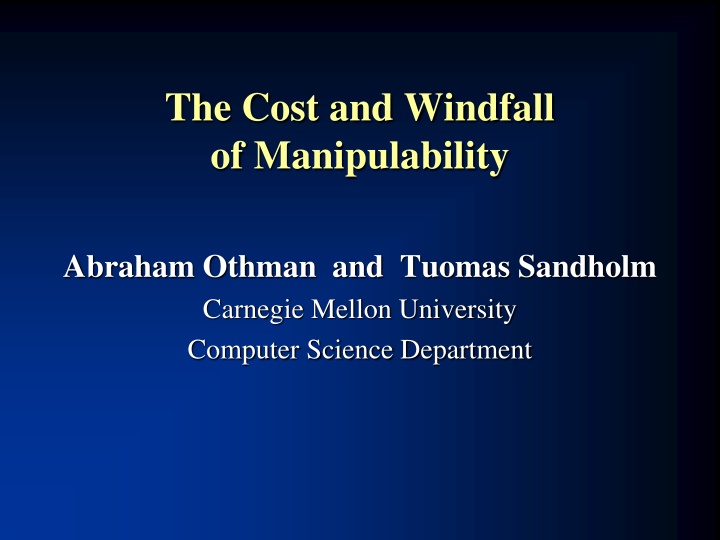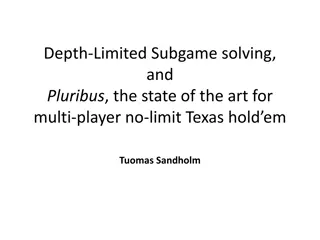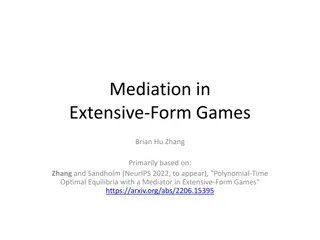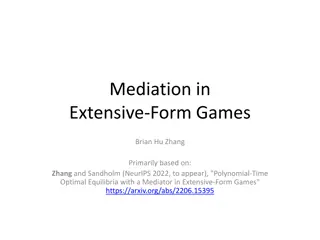
Mechanism Design for Optimal Results
Delve into the fascinating world of mechanism design with a focus on manipulation-optimal mechanisms. Explore topics such as the cost of manipulability, the revelation principle, and examples showcasing the application of optimal mechanisms in decision-making scenarios.
Download Presentation

Please find below an Image/Link to download the presentation.
The content on the website is provided AS IS for your information and personal use only. It may not be sold, licensed, or shared on other websites without obtaining consent from the author. If you encounter any issues during the download, it is possible that the publisher has removed the file from their server.
You are allowed to download the files provided on this website for personal or commercial use, subject to the condition that they are used lawfully. All files are the property of their respective owners.
The content on the website is provided AS IS for your information and personal use only. It may not be sold, licensed, or shared on other websites without obtaining consent from the author.
E N D
Presentation Transcript
The Cost and Windfall of Manipulability Abraham Othman and Tuomas Sandholm Carnegie Mellon University Computer Science Department
The revelation principle Foundational result of mechanism design Equivalence of manipulable & truthful mechanisms Only applies if all agents in the manipulable mechanism behave optimally
Questions Agents might act irrationally due to: Computational limitations Stupidity/trembling Behavioral/cognitive biases Then, can mechanism designer get a better result? be protected from bad results?
Manipulation optimal mechanisms (MOMs) Def. A manipulable mechanism is manipulation optimal if Any agent with a manipulable type failing in any way to play his optimal manipulation yields strictly greater mechanism utility If all agents play rationally, the mechanism s utility equals that of an optimal truthful mechanism Here optimal means not Pareto-dominated by any other truthful mechanism We don t need a model of irrationality
Example of this property [Conitzer & Sandholm 04] A manager and HR director are trying to select a team of k people for a task, from n employees Some employees are friends. Friend relationships are mutual and are common knowledge
Example, continued HR director prefers team to have friends on it She gets utility 2 if team has friends, 0 otherwise Manager has a type either he has a preference for a specific team, or no team preference Manager gets a base payoff 1 if the selected team has no friends, 0 otherwise If manager has a type corresponding to a specific team and that team is selected, he gets a bonus 3
Team selection mechanisms If manager reports a team preference, select that team Optimal truthful mechanism: If manager reports no team preference, select a team without friends (mechanism utility = 1) Manipulation-optimal: If manager reports no team preference, select a team with friends (mechanism utility = 2) Manager s no-team-preference type is manipulable because he could state a preference for an arbitrary team w/o friends But finding a team w/o friends is NP-hard
Settings for MOMs That was an existence result for a single-agent affine-welfare maximization objective HR director had only one type => no need to report What about other settings?
General impossibility Theorem. No mechanism can satisfy the first characteristic of MOMs (doing strictly better through sub-optimal play) if any agent has more than one distinct manipulable type Proof sketch. Let a and b be manipulable types with different optimal strategic plays What happens if agent of type a plays the optimal revelation for type b, and vice-versa? Mechanism must do better than if agents had played correctly, but there s a reason those plays weren t optimal for the agent Holds for Nash equilibrium => impossibility for stronger solution concepts
Working within the impossibility We prove that single-player MOMs if objective is social welfare multi-player MOMs if objective is social welfare But not in dominant strategies with symmetry and anonymity multi-player MOMs if objective is affine welfare even in dominant strategies with symmetry and anonymity
Proof (1/4) Proof by construction. Each agent has type a or a Our mechanism: Report a a Outcome 1 Outcome 2 a Outcome 3 Outcome 4 a The challenge is fixing the payoffs appropriately
Proof (2/4) Payoffs for type a: Payoffs for type a : Report a Report a a a {3,4} {5,0} a {1,1} {4,0} a' {0,6} {0,0} a {0,3} {3,0} a Reporting a regardless of true type is a DSE
Proof (3/4) Two parts in proving that this mechanism is manipulation-optimal: First, if one or both of the agents with true type a play a instead of manipulating to a , social welfare strictly increases E.g. if both are truly a: Report a a {1,1}, DSE sum = 2 {4,0} sum = 4 a' {0,3} sum = 3 {3,0} sum = 3 a
Proof (4/4) Truthful analogue to our mechanism maps any report to outcome 1 For our mechanism to be manipulation optimal, this truthful analogue must not be Pareto- dominated by any truthful mechanism Outcome 1 maximizes social welfare when both agents have type a , and any truthful mechanism which selects outcome 1 for that input must select outcome 1 for every input
Conclusions Can we use manipulability to guarantee better results if agents fail to be rational in any way? No If any agent has more than one manipulable type In single-agent settings if objective is social welfare In DSE for social-welfare maximization with symmetric, anonymous agents Yes For some social welfare maximization settings, even in DSE For some affine welfare maximization settings, even in DSE with symmetry & anonymity In settings where answer is No , using a manipulable mechanism exposes designer to outcomes worse than best truthful mechanism
Getting around the impossibilities Our impossibility results place strong constraints on MOMs When mistakes can be arbitrary, only in very limited settings can MOMs exist Circumventing impossibility Imposing natural restrictions on strategies Combining behavioral models and priors with automated mechanism design



